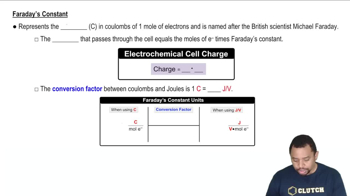Here are the essential concepts you must grasp in order to answer the question correctly.
Electrolysis
Electrolysis is a chemical process that uses electrical energy to drive a non-spontaneous reaction. In the case of molten CaCl2, the application of an electric current causes the compound to dissociate into calcium and chlorine ions, allowing for the production of elemental calcium at the cathode and chlorine gas at the anode.
Recommended video:
Faraday's Laws of Electrolysis
Faraday's Laws of Electrolysis quantify the relationship between the amount of substance produced at an electrode and the electric charge passed through the electrolyte. The first law states that the mass of a substance produced is directly proportional to the quantity of electricity that passes through the cell, which can be calculated using the formula: mass = (current × time × molar mass) / (n × F), where n is the number of moles of electrons and F is Faraday's constant.
Recommended video:
Faraday's Constant in Electrochemistry
Efficiency of Electrolytic Cells
The efficiency of an electrolytic cell refers to the ratio of the actual amount of product obtained to the theoretical amount predicted by Faraday's laws. In this case, the cell's efficiency is given as 68%, meaning that only 68% of the theoretical yield of calcium will be produced under the specified conditions. This efficiency must be factored into calculations to determine the actual mass of calcium produced.
Recommended video:
 Verified step by step guidance
Verified step by step guidance

